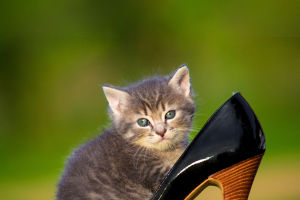When you first bring home a cat, one of the first things you'll likely notice is its fascination with cardboard boxes. Even when you discard the delivery box after receiving carefully selected cat litter, the cat will silently make its way towards it.
Is the soft cat litter not as comfortable as a sturdy cardboard shell?
Over time, if you observe cats, you'll notice that they occupy all the small and large cardboard boxes in the house. No cat can resist the allure of a cardboard box, even using it as the ideal nesting place for a pregnant mother cat.
Upon spotting a cardboard box, a cat's typical behavior involves circling it, sniffing it, and joyfully leaping inside. Size doesn't matter to some cats, as they skillfully squeeze themselves into the box. Others use larger cardboard boxes as temporary nests, pawing and even chewing on them.
Cats display happiness and comfort when encountering cardboard boxes. This behavior isn't exclusive to domestic cats; felines of all sizes, from tigers and lions to medium-sized lynxes and caracals, exhibit a kitten-like enthusiasm when faced with a cardboard box.
How do "big cats" react to cardboard boxes?
A male lion, for instance, happily walks around the box and nudges it with its head, but doesn't jump in. Instead, it crushes the box into paper and lies on top of it. Similarly, the two tigers in the test initially playfully push the box with their heads, then both jump into the box, sit for a while, and finally flatten the box.
The lynxes, caracals, and even a panther in the test all respond in the same manner as kittens. They eagerly approach the cardboard box, paw at it, jump inside, and use it as a spot for grooming and sunbathing.
It's fascinating to note that while we humans try various methods to capture cats' attention and affection, the simple cardboard box manages to win the hearts of the entire feline family.
Why do cats and other felines have such a strong affinity for cardboard boxes.?
As former inhabitants of the wild, cats naturally have an inclination for hiding and seeking out narrow spaces. Cardboard boxes, being enclosed on all sides while still allowing a view of the outside, provide a secure and comforting environment for felines.
Cats have specific environmental preferences, including temperature, humidity, smell, and privacy, which vary for each individual cat. More cautious cats prefer sleeping in high places, under beds, or sofas, where they can hide effectively.
Cats also seek hiding spots during certain situations, such as encountering a new environment or unfamiliar visitors. If a cat comfortably wanders around the house and falls asleep wherever it pleases, it indicates that the cat feels safe in that environment.
Additionally, the material of cardboard boxes perfectly suits cats' needs. Cats can use them for scratching, playing, hiding, observing, and resting.
A cardboard box fulfills these requirements, whereas a cat bed serves primarily as a resting place. It would be narrow-minded to equate a cardboard box to a cat bed, as they fulfill different purposes.
The enclosed and sheltered nature of a cat nest, such as the sides of a cardboard box, holds a mysterious appeal for cats, attracting them to cross over and enter.
Therefore, it's clear that kittens are not being foolish by favoring cardboard boxes over cat beds. Cats themselves instinctively know what is most comfortable for them.


